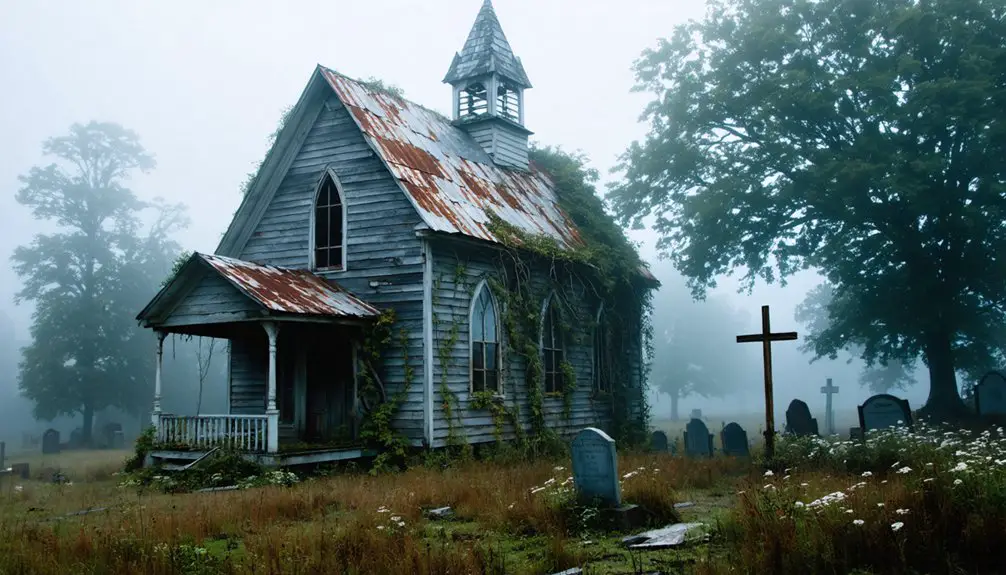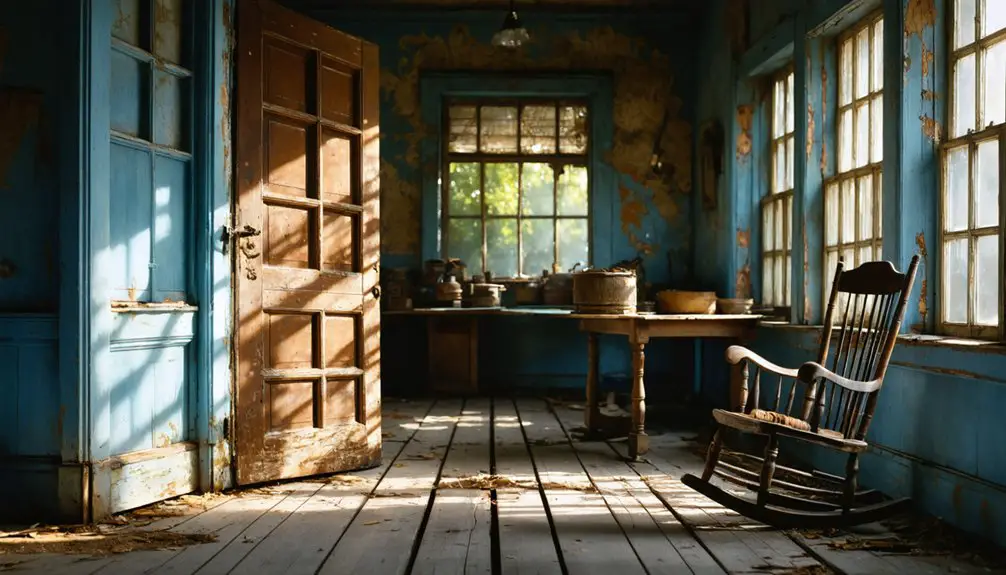You’ll find Fillmore’s ghost town ruins in central Pennsylvania, established in 1886 by the Berwind-White Coal Mining Company. The self-contained mining community once supported 1,000 residents with theaters, banks, and schools until devastating events struck – the 1936 St. Patrick’s Day Flood and a 1962 landfill fire forced evacuations. Today, stone foundations and deteriorating streets remain, while underground fires still burn at 900°F beneath the abandoned town’s surface, creating an eerie landscape with mysterious tales to uncover.
Key Takeaways
- Fillmore, Pennsylvania was established in 1886 by the Berwind-White Coal Mining Company and housed approximately 1,000 residents during its peak.
- The Great St. Patrick’s Day Flood of 1936 severely damaged the town’s infrastructure, leading to population decline and eventual abandonment.
- Underground mine fires reaching 900°F, toxic gases, and soil contamination from coal mining create ongoing environmental hazards in the area.
- Local legends speak of seven supernatural gates and ghostly encounters, adding to the abandoned town’s mysterious reputation.
- Stone foundations, deteriorating streets, and the Oddfellows Cemetery remain as physical evidence of Fillmore’s mining town past.
The Rise of a Mining Community
When the Berwind brothers established the Berwind-White Coal Mining Company in 1886, they laid the foundation for Fillmore’s transformation into a bustling mining community.
Building upon their mining expertise from the 1860s, they expanded their operations using traditional room-and-pillar mining techniques to extract the region’s rich bituminous coal deposits. The miners could typically achieve coal recovery rates between 35% and 70% using this method.
You’ll find that Fillmore’s community structure grew directly from the company’s vertical integration strategy.
The Wilmore Real Estate Company, managing housing and farms for workers, created a self-contained town where everything revolved around coal production.
Wilmore Real Estate’s company town model ensured workers lived and breathed coal, with every aspect of daily life supporting mine operations.
The arrival of the Erie Railroad connected Fillmore to major markets, while the construction of breakers and processing facilities provided the infrastructure necessary for large-scale mining operations.
This complete integration of work and life defined Fillmore’s early development, as the town prospered alongside the growing demands of America’s steel and railroad industries.
Under the leadership of Edward J. Berwind, who served as president from 1890 to 1936, the company experienced significant growth and development in the region.
Historical Timeline and Key Events
While Fillmore’s mining roots established its foundation, a series of significant events shaped the town’s eventual decline.
Similar to railroad bypasses, transportation routes played a crucial role in the fate of many small towns during the late 1800s.
You’ll find striking parallels between Fillmore and neighboring Centralia, as both communities faced similar fates tied to Pennsylvania’s anthracite mining industry.
In Centralia, cultural influences and mining technology shaped a thriving community of 1,200 residents in the early 1900s.
Temperatures in the underground fire reached over 900 degrees, creating dangerous conditions throughout the area.
However, everything changed on May 27, 1962, when a fateful trash fire ignited an underground inferno that would burn for decades.
Despite multiple containment efforts through the 1960s and early 1970s, including trenches and fly ash barriers, the fire continued to spread.
Industrial Heritage and Economic Impact
The discovery of anthracite coal in 1856 sparked Fillmore’s transformation into a bustling industrial hub, anchored by major operations like the Locust Run, Coal Ridge, and Hazeldell Colliery mines.
Under the Locust Mountain Coal and Iron Company’s leadership, the town grew to support 1,000 residents with diverse amenities including banks, theaters, and schools.
The Molly Maguires’ violence plagued early mining operations, creating an atmosphere of fear and instability throughout the region.
The Irish Catholic immigrants who arrived in the 1850s mining boom established deep roots in the community, building churches and shaping local culture.
You’ll find that mining practices during the Great Depression, particularly “pillar-robbing,” set the stage for future industrial decline.
These unregulated techniques weakened underground structures, making mining increasingly dangerous and less viable.
When the 1962 landfill fire ignited coal seams beneath the town, it delivered the final blow to Fillmore’s economy.
The resulting evacuations, property condemnations, and government buyouts led to the complete collapse of this once-thriving mining community.
Tales and Legends of Fillmore
Beyond its industrial decline, Fillmore’s abandoned landscape now harbors a darker reputation steeped in supernatural lore.
You’ll hear tales of ghostly encounters throughout the forest, where visitors report blood-curdling screams and shadowy figures near mysterious iron gates marked with strange symbols. Local legends speak of seven gates that supposedly lead to the underworld, trapping restless spirits of former residents within their boundaries. Similar to York County’s infamous Seven Gates of Hell, these portals are said to contain vengeful spirits of the dead.
Paranormal investigators have documented unexplained phenomena here, including electronic voice recordings and cold spots around the ruins. Reports include sightings of a demonic red-eyed figure stalking visitors at night.
The ghostly reputation stems from historical tragedies like fires and floods, which locals attribute to ancient curses.
Whether you’re a skeptic or believer, you can’t deny that spectral sightings and eerie experiences continue to shape Fillmore’s identity, drawing curious visitors to this haunted Pennsylvania ghost town.
The Path to Abandonment
During March 1936, Livermore suffered a devastating flood known as “The Great St. Patrick’s Day Flood,” when 18 feet of water submerged the town.
Despite the community’s resilience in evacuating residents by rowboat to Blairsville, the disaster claimed one local life and destroyed essential infrastructure, including the Conemaugh River bridge and 14 buildings.
Much like Centralia’s coal fire, the disaster marked the beginning of the town’s slow decline toward abandonment.
The flood’s destruction of the Pennsylvania Canal’s Juniata Branch crippled economic recovery efforts, severing critical trade routes.
Following the catastrophe, the U.S. Army Corps of Engineers implemented flood control measures, constructing the Conemaugh River Dam near Tunnelton.
This project required Livermore’s sacrifice – by the early 1950s, the remaining 57 residents were relocated, and the town was partially razed to create a protective floodplain.
Today, nature has reclaimed the former townsite, leaving only scattered ruins as evidence of Livermore’s existence. The area now serves as one of many disambiguation references to the name Livermore across America.
Environmental Legacy and Safety Hazards
After decades of underground coal fires, Fillmore’s environmental legacy reveals a haunting collection of hazards that continue threatening public safety.
You’ll find soil contaminated with coal ash, heavy metals, and sulfur compounds leaching into local waterways. The ground beneath your feet isn’t stable – sinkholes and cracks have formed as the underground inferno weakens the earth’s structure, with temperatures reaching over 900°F in some zones.
Despite government intervention and $42 million in remediation efforts, environmental hazards persist.
You’ll notice fenced-off areas where toxic gases still seep through vents, while abandoned mines and waste sites create ongoing ecological risks. Safety measures now restrict access to much of the area, as authorities monitor gas levels and maintain barriers around the most dangerous zones.
Life in Fillmore’s Peak Years

While Pennsylvania’s coal industry boomed in the late 1800s, Fillmore emerged as a quintessential company town under the control of Berwind White Coal Mining Co.
You’d find immigrant workers from diverse backgrounds living in company-owned houses, their daily lives revolving around the demanding mining schedules and tight-knit community bonds.
Your world would’ve centered on the mine’s rhythm, where you’d work underground or in surface operations, processing and shipping coal to Pittsburgh’s steel mills.
Beyond work, you’d participate in cultural events and religious gatherings that strengthened immigrant experiences and community solidarity.
Though the company controlled everything from housing to stores, you’d find comfort in shared experiences with neighbors, gathering at local churches and schools.
Local farms and dairy operations provided fresh food, creating a self-sufficient but company-dependent lifestyle.
What Remains Today
Today’s visitor to Fillmore encounters a landscape where nature steadily reclaims the remnants of human habitation.
You’ll find stone foundations and walls tracing former buildings’ footprints, while overgrown vegetation fills the cracks of deteriorating streets and sidewalks. The ghost town remnants include the original street grid, though most structures have collapsed into roofless ruins.
The Oddfellows Cemetery stands as a powerful memorial to Fillmore’s past, with tilted tombstones bearing witness to the shifting ground caused by underground fires.
Throughout the site, natural reclamation continues unabated – trees and brush encroach on once-bustling areas, while grass blankets vacant lots.
Time and nature march forward relentlessly, as vegetation slowly consumes what remains of human presence in abandoned spaces.
You won’t find any permanent residents or active buildings here, just the quiet desolation of a town frozen in time.
Photography and Urban Exploration Guide

To capture Fillmore’s haunting beauty effectively, you’ll need proper equipment and preparation for urban exploration photography. Pack a DSLR or mirrorless camera with multiple lenses, including a wide-angle for vast interiors and a prime lens for detailed shots.
Don’t forget your tripod for those essential long exposures in dark spaces. For the best shots, visit during early morning or late afternoon when natural light creates dramatic shadows. You’ll find overcast days perfect for moody atmospheres.
Frame your compositions through broken windows and doorways, and use leading lines from old roads and railways to draw viewers in. Remember to wear protective gear, bring a first-aid kit, and explore with companions.
Always respect the site by staying on established paths and never removing artifacts – your role is to document, not disturb.
Preservation Efforts and Future Outlook
You’ll find Fillmore’s preservation initiatives center on restoring the historic buildings through state-funded grants and local preservation partnerships.
The site’s natural area management plan focuses on controlling invasive vegetation while maintaining safe access to key structures and pathways.
Local historians and community members actively document the town’s history through photography, oral histories, and archival research projects that’ll help guide future preservation decisions.
Historical Building Restoration
Since the early preservation efforts began, Fillmore’s historical buildings have undergone extensive restoration work guided by detailed documentation from the Historic American Building Survey.
The restoration techniques focus on maintaining architectural authenticity through period-specific construction materials and methods. You’ll find limestone exterior walls, like those of the Boalsburg Tavern, have helped preserve structures despite fire damage.
Workers have stabilized foundations and roof structures to counter age-related deterioration and mining-induced ground shifts.
The restoration encompasses residential homes, company stores, and community buildings dating from the mid-19th to mid-20th century. Crews have removed debris from neglected sites to prevent further damage, while caretakers now monitor and maintain these historic properties.
Through these efforts, you can experience Fillmore’s rich history in its authentically restored buildings.
Natural Area Management
Beyond the restored buildings, Fillmore’s natural landscape receives intensive preservation attention through thorough forest management strategies.
You’ll find sustainable timber harvests carefully planned to create diverse habitats while maintaining the area’s economic value. Through focused habitat restoration efforts, native species like Eastern hemlock, white pine, and red maple flourish alongside rich understory vegetation.
The management team’s work extends to rehabilitating abandoned roads and constructing accessible trails, allowing you to explore while protecting the forest’s ecological integrity.
You can enjoy fishing sites and horse trails while volunteer stewardship programs keep these areas maintained. Conservation efforts have expanded to include strategic land acquisitions, ensuring the protection of contiguous forest tracts and essential wildlife corridors.
This preservation supports over 100 bird species and numerous mammals, including fishers, mink, and river otters.
Community Documentation Projects
Extensive documentation projects preserve Fillmore’s rich heritage through a combination of traditional and digital methods.
You’ll find local historical societies maintaining thorough archival collections that include photographs, maps, and property records chronicling the town’s evolution. The digitization of old newspapers and census data provides insights into demographic shifts, while oral histories from descendants offer intimate perspectives of life in Fillmore.
Partnerships with Pennsylvania state archives guarantee proper cataloging of the town’s industrial past, complemented by scholarly research from regional universities.
The documentation extends beyond paper records – you can now explore Fillmore through 3D scans, drone photography, and virtual tours. These digital innovations help protect the site’s history while making it accessible to researchers and curious minds worldwide.
Frequently Asked Questions
What Role Did Native American Tribes Play in Fillmore’s Early History?
You’ll find that Native land around Fillmore belonged to Susquehannocks, Lenape, and Shawnee tribes, whose tribal influence shaped early trade networks, settlement patterns, and colonial relations through the 1700s.
How Did the Great Depression Specifically Impact Fillmore’s Mining Operations?
Like countless miners who lost everything, you’d have seen Fillmore’s economic decline hit hard in the 1930s, with widespread mining layoffs forcing workers into bootleg mining just to survive.
Were There Any Notable Crimes or Murders Recorded in Fillmore?
You won’t find any documented murders or notable crimes in historical records. While many ghost towns have unsolved mysteries and dark crime history, no specific criminal incidents were officially recorded here.
What Religious Institutions or Churches Existed in Fillmore Before Abandonment?
You’d find the Ukrainian Catholic Church as the main religious center, featuring distinct church architecture, plus two Catholic parochial schools. Community gatherings centered around these institutions before Fillmore’s decline.
Did Any Famous Historical Figures Ever Visit or Stay in Fillmore?
You’ll be disappointed to learn there’s no documented evidence of famous visitors making their way to this forgotten spot. Historical events nearby drew notable figures, but none left footprints in Fillmore itself.
References
- https://pittsburghghosts.com/livermore-pennsylvania-ghost-town/
- https://www.islands.com/1824527/america-burning-ghost-town-once-thriving-quintessential-mining-destination-pennsylvania-centralia-fire/
- https://www.legendsofamerica.com/centralia-pennsylvania/
- https://www.youtube.com/watch?v=Qj5LjacccJ0
- https://www.roadunraveled.com/blog/centralia-modern-day-ghost-town/
- http://as-iup.klnpa.org/repositories/2/resources/219
- https://www.pa.gov/agencies/dep/programs-and-services/mining/bureau-of-mining-programs/pa-mining-history.html
- https://undergroundminers.com/underwood-colliery/
- https://en.wikipedia.org/wiki/History_of_anthracite_coal_mining_in_Pennsylvania
- https://www.pghcitypaper.com/arts-entertainment/preserving-the-radical-history-of-pennsylvanias-bootleg-coal-miners-22370668



